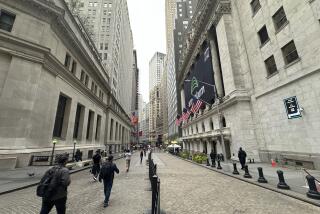Wall Street bucks global slump
- Share via
NEW YORK — After bracing for a steep fall, Wall Street barely shrugged at a sharp sell-off in stock markets around the globe.
It all started in Asia. Weak manufacturing data out of China pointed to a slowdown in the world’s second-largest economy, sending the region’s stock indexes into a tailspin. Japan’s Nikkei plunged 7.3% on Thursday.
Investor jitters then spilled over into Europe, where major stock indexes dived 2%.
Wall Street opened deep into the red, with major indexes initially falling about 1%. The Dow Jones industrial average sunk more than 100 points shortly after the opening bell on the New York Stock Exchange.
But as trading continued, investors flocked back, paring the day’s losses and highlighting the momentum of this year’s stock rally.
“It really demonstrates the resilience of the market,” said Erik Davidson, deputy chief investment officer and executive vice president at Wells Fargo Private Bank.
The Dow ended the day off only 12.67 points, or 0.08%, to 15,294.50. The broader Standard & Poor’s 500 index lost 4.84 points, or 0.29%, to 1,650.51. The technology-heavy Nasdaq slid 3.88 points, or 0.11%, to 3,459.42.
Despite U.S. stocks’ mild slide, and a sharper decline the previous day, the Dow is up 16.7% for the year. Although some on Wall Street are questioning how long the sharp run-up in stocks can last, other analysts have been advising investors to buy when the market sags.
Some analysts have been calling for a correction of perhaps 10% at some point. But bulls believe the market has more room to run. They argue that stocks, although by no means cheap, are pretty reasonably priced, especially compared with bonds.
Investors have been plowing their sidelined cash into the stock market this year in large part because of the Federal Reserve’s unprecedented stimulus program.
The central bank has been pumping $85 billion into the economy each month. By buying bonds, the Fed’s aim has been to push down interest rates and make borrowing cheaper and easier.
That in turn has made havens such as fixed-income securities and savings accounts less attractive, prompting investors looking for meaningful returns to plunge into riskier investments like stocks.
In a way, the market’s non-reaction Thursday may highlight just how much Fed stimulus has been driving the stock market.
By contrast, investors Wednesday sent the Dow on a swing of more than 250 points between Fed Chairman Ben S. Bernanke’s testimony before Congress and the central bank’s release of meeting minutes later in the day. Investors were left deciphering Fed signals about when it might start turning off its spigot.
“Obviously the Fed has been helping out a lot for a long time,” Davidson said. “That’s not their primary objective — to support the stock market — but free money can do amazing things.”
It’s not just the Fed’s easy-money policies buoying investors, however. For one, the Nikkei’s sharp plunge was perhaps a long-overdue pull-back. Japan’s stock market is still up a whopping 39% for the year, even after the sell-off.
The U.S. economy is also showing continued signs of strength.
The U.S. Labor Department reported Thursday that 340,000 people filed for first-time unemployment benefits in the week ended Saturday, falling from a revised 363,000 the previous week. Economists had expected initial jobless claims to fall to 345,000 last week.
The housing market also gained strength in April. Sales of newly built, single-family homes rose 2.3% above the prior month and were 29% higher than the same period last year. New homes sold at a seasonally adjusted annual rate of 454,000 units, the Commerce Department said Thursday.
Times staff writers Jim Puzzanghera in Washington and Alejandro Lazo in Los Angeles contributed to this report.
More to Read
Inside the business of entertainment
The Wide Shot brings you news, analysis and insights on everything from streaming wars to production — and what it all means for the future.
You may occasionally receive promotional content from the Los Angeles Times.










